China's Economy: Exchange Rate Appreciation and Future Challenges
VerifiedAdded on 2022/08/13
|16
|2983
|54
Report
AI Summary
This report provides a detailed analysis of the Chinese economy, focusing on key macroeconomic indicators such as GDP growth, unemployment, inflation, and current account balance over the past two decades. It examines the impact of exchange rate appreciation on China's current account, considering the effects on trade balance and net exports. The report delves into the challenges faced by the Chinese economy in the near future, including slowing economic growth, environmental issues, demographic shifts, and productivity concerns. The analysis utilizes empirical research methods, incorporating data from the World Bank and other sources to support its findings. The report concludes with recommendations for policy considerations regarding the exchange rate and overall economic stability, addressing the potential implications of currency appreciation and other economic factors. The report is prepared for the Asia and Pacific Department of the International Monetary Fund, offering an objective and data-driven assessment of the Chinese economy.
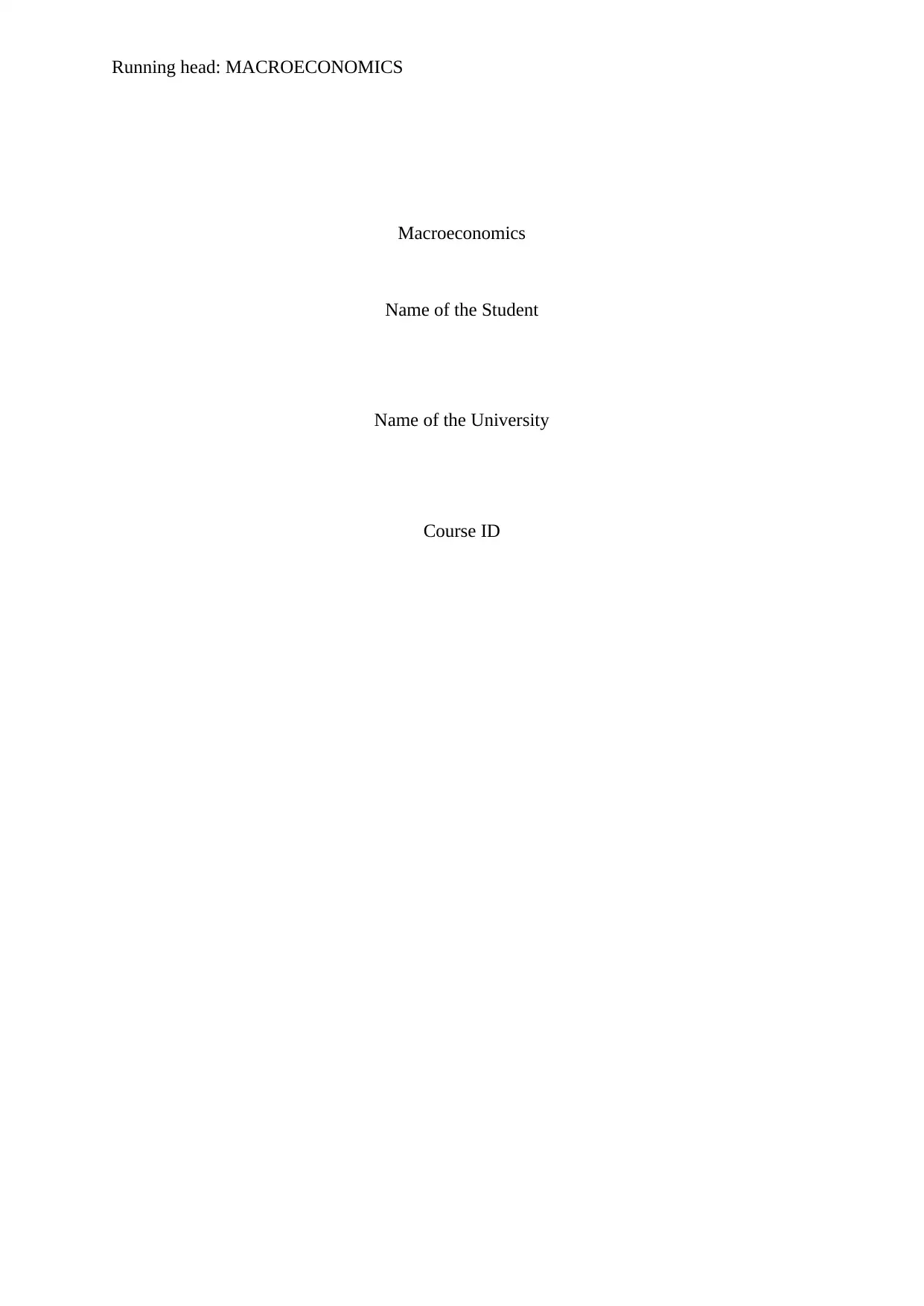
Running head: MACROECONOMICS
Macroeconomics
Name of the Student
Name of the University
Course ID
Macroeconomics
Name of the Student
Name of the University
Course ID
Paraphrase This Document
Need a fresh take? Get an instant paraphrase of this document with our AI Paraphraser
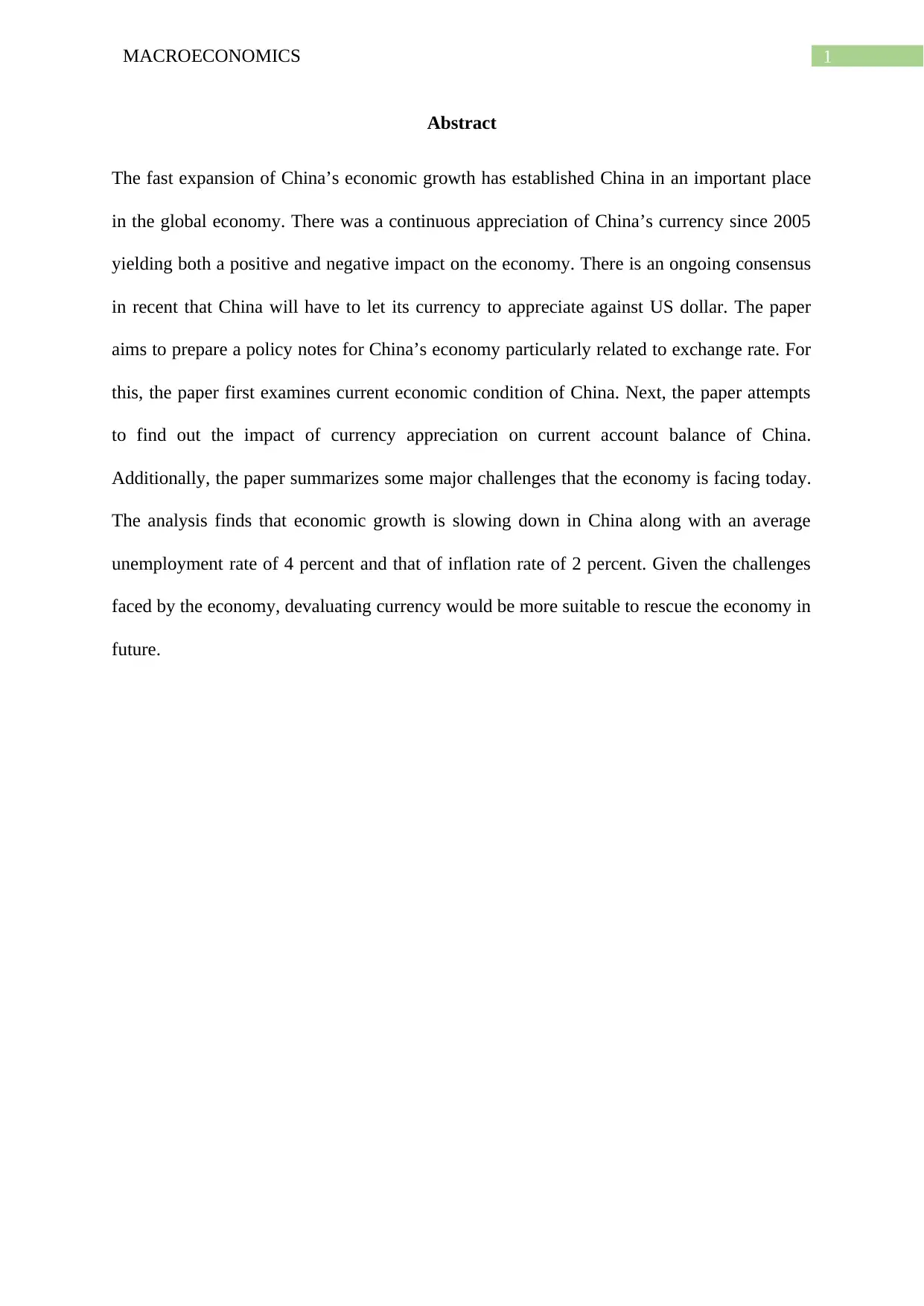
1MACROECONOMICS
Abstract
The fast expansion of China’s economic growth has established China in an important place
in the global economy. There was a continuous appreciation of China’s currency since 2005
yielding both a positive and negative impact on the economy. There is an ongoing consensus
in recent that China will have to let its currency to appreciate against US dollar. The paper
aims to prepare a policy notes for China’s economy particularly related to exchange rate. For
this, the paper first examines current economic condition of China. Next, the paper attempts
to find out the impact of currency appreciation on current account balance of China.
Additionally, the paper summarizes some major challenges that the economy is facing today.
The analysis finds that economic growth is slowing down in China along with an average
unemployment rate of 4 percent and that of inflation rate of 2 percent. Given the challenges
faced by the economy, devaluating currency would be more suitable to rescue the economy in
future.
Abstract
The fast expansion of China’s economic growth has established China in an important place
in the global economy. There was a continuous appreciation of China’s currency since 2005
yielding both a positive and negative impact on the economy. There is an ongoing consensus
in recent that China will have to let its currency to appreciate against US dollar. The paper
aims to prepare a policy notes for China’s economy particularly related to exchange rate. For
this, the paper first examines current economic condition of China. Next, the paper attempts
to find out the impact of currency appreciation on current account balance of China.
Additionally, the paper summarizes some major challenges that the economy is facing today.
The analysis finds that economic growth is slowing down in China along with an average
unemployment rate of 4 percent and that of inflation rate of 2 percent. Given the challenges
faced by the economy, devaluating currency would be more suitable to rescue the economy in
future.

2MACROECONOMICS
Table of Contents
Introduction................................................................................................................................3
Background............................................................................................................................3
Purpose...................................................................................................................................3
Scope......................................................................................................................................4
Method of investigation.........................................................................................................4
Introduction to Chinese economy..............................................................................................5
GDP growth...........................................................................................................................5
Unemployment.......................................................................................................................6
Inflation..................................................................................................................................7
Current account balance.........................................................................................................8
Effect of appreciation of exchange rate on current account.......................................................8
Challenges for Chinese economy.............................................................................................12
Conclusion................................................................................................................................13
Bibliography.............................................................................................................................14
Table of Contents
Introduction................................................................................................................................3
Background............................................................................................................................3
Purpose...................................................................................................................................3
Scope......................................................................................................................................4
Method of investigation.........................................................................................................4
Introduction to Chinese economy..............................................................................................5
GDP growth...........................................................................................................................5
Unemployment.......................................................................................................................6
Inflation..................................................................................................................................7
Current account balance.........................................................................................................8
Effect of appreciation of exchange rate on current account.......................................................8
Challenges for Chinese economy.............................................................................................12
Conclusion................................................................................................................................13
Bibliography.............................................................................................................................14
⊘ This is a preview!⊘
Do you want full access?
Subscribe today to unlock all pages.

Trusted by 1+ million students worldwide
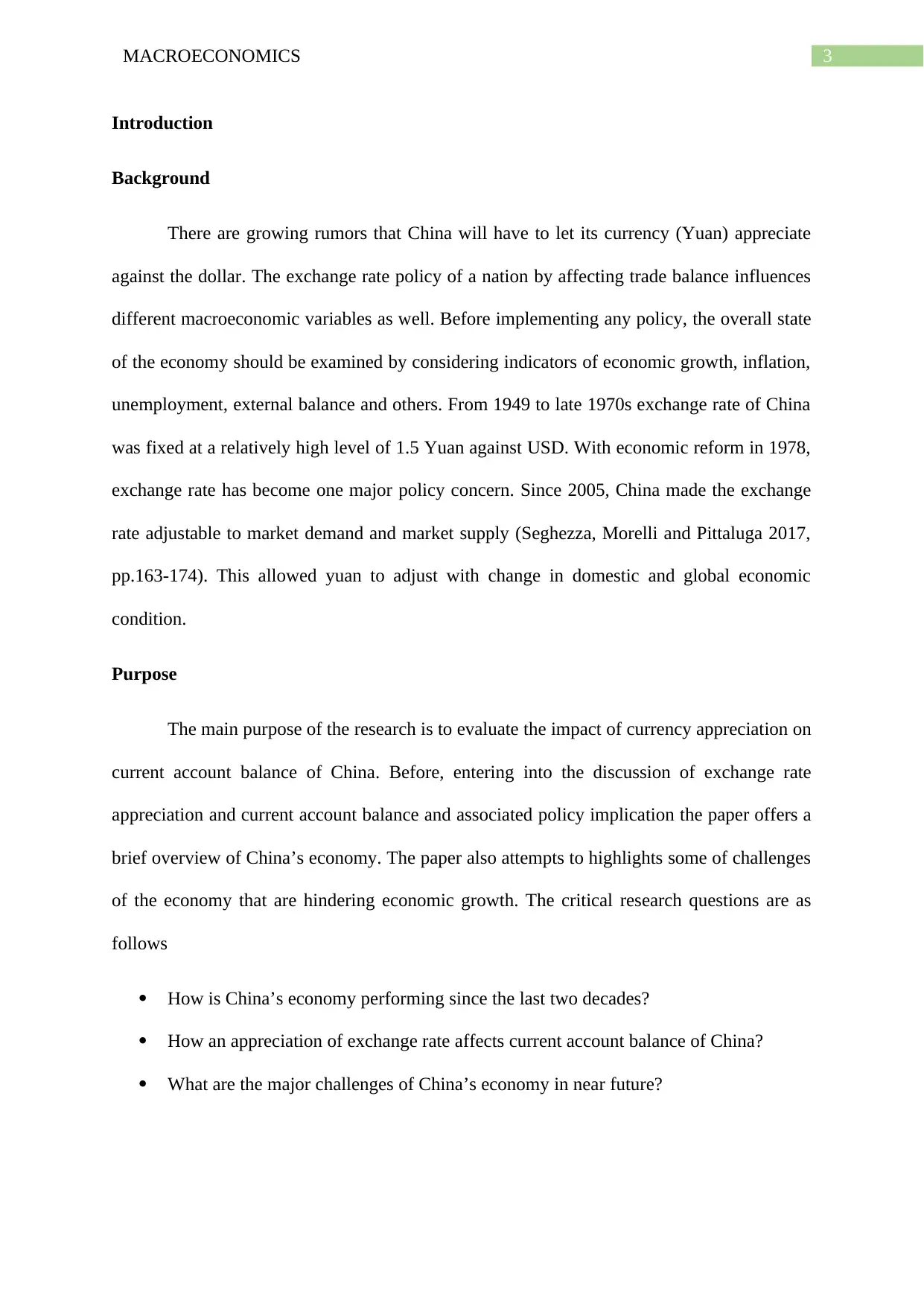
3MACROECONOMICS
Introduction
Background
There are growing rumors that China will have to let its currency (Yuan) appreciate
against the dollar. The exchange rate policy of a nation by affecting trade balance influences
different macroeconomic variables as well. Before implementing any policy, the overall state
of the economy should be examined by considering indicators of economic growth, inflation,
unemployment, external balance and others. From 1949 to late 1970s exchange rate of China
was fixed at a relatively high level of 1.5 Yuan against USD. With economic reform in 1978,
exchange rate has become one major policy concern. Since 2005, China made the exchange
rate adjustable to market demand and market supply (Seghezza, Morelli and Pittaluga 2017,
pp.163-174). This allowed yuan to adjust with change in domestic and global economic
condition.
Purpose
The main purpose of the research is to evaluate the impact of currency appreciation on
current account balance of China. Before, entering into the discussion of exchange rate
appreciation and current account balance and associated policy implication the paper offers a
brief overview of China’s economy. The paper also attempts to highlights some of challenges
of the economy that are hindering economic growth. The critical research questions are as
follows
How is China’s economy performing since the last two decades?
How an appreciation of exchange rate affects current account balance of China?
What are the major challenges of China’s economy in near future?
Introduction
Background
There are growing rumors that China will have to let its currency (Yuan) appreciate
against the dollar. The exchange rate policy of a nation by affecting trade balance influences
different macroeconomic variables as well. Before implementing any policy, the overall state
of the economy should be examined by considering indicators of economic growth, inflation,
unemployment, external balance and others. From 1949 to late 1970s exchange rate of China
was fixed at a relatively high level of 1.5 Yuan against USD. With economic reform in 1978,
exchange rate has become one major policy concern. Since 2005, China made the exchange
rate adjustable to market demand and market supply (Seghezza, Morelli and Pittaluga 2017,
pp.163-174). This allowed yuan to adjust with change in domestic and global economic
condition.
Purpose
The main purpose of the research is to evaluate the impact of currency appreciation on
current account balance of China. Before, entering into the discussion of exchange rate
appreciation and current account balance and associated policy implication the paper offers a
brief overview of China’s economy. The paper also attempts to highlights some of challenges
of the economy that are hindering economic growth. The critical research questions are as
follows
How is China’s economy performing since the last two decades?
How an appreciation of exchange rate affects current account balance of China?
What are the major challenges of China’s economy in near future?
Paraphrase This Document
Need a fresh take? Get an instant paraphrase of this document with our AI Paraphraser
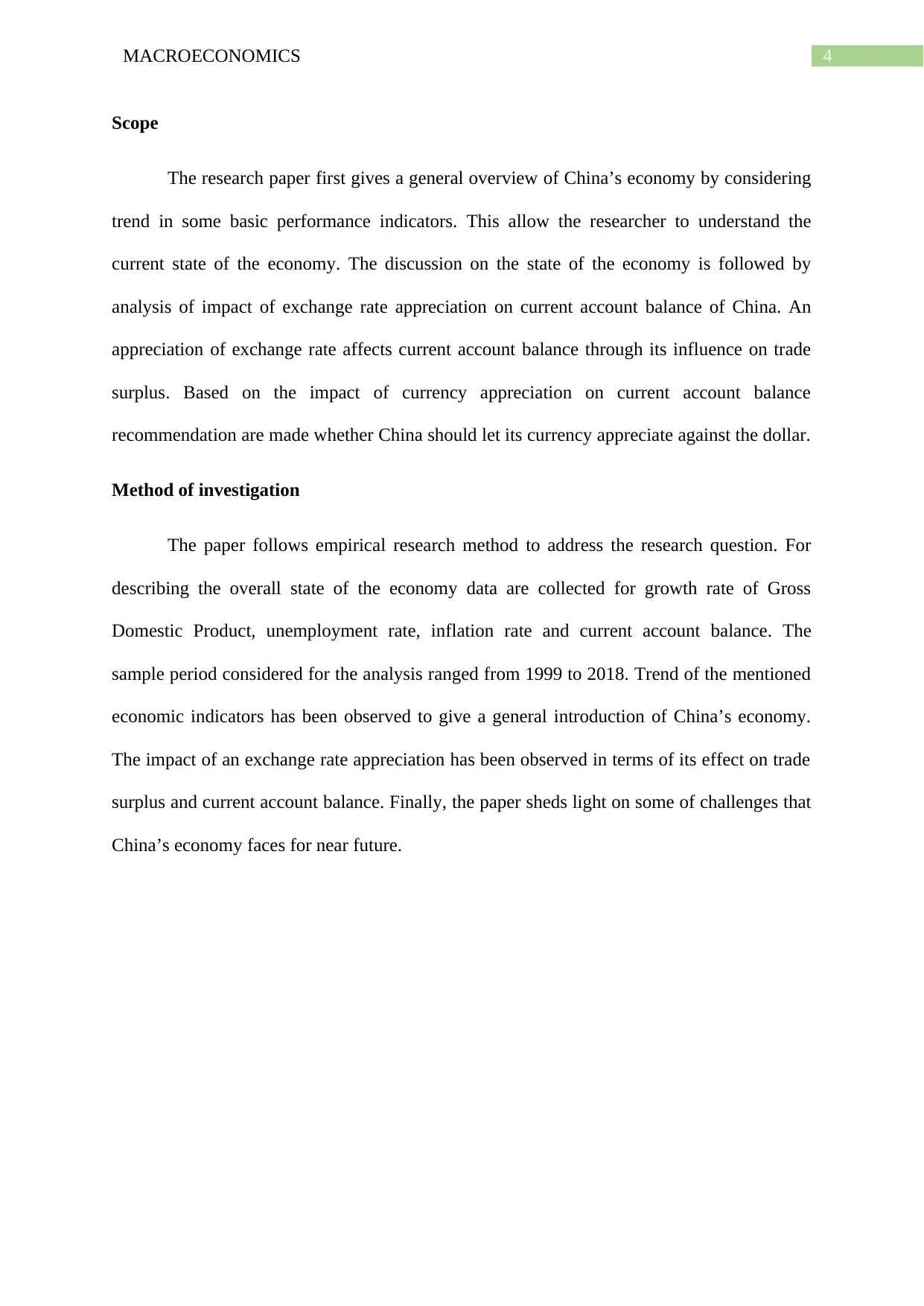
4MACROECONOMICS
Scope
The research paper first gives a general overview of China’s economy by considering
trend in some basic performance indicators. This allow the researcher to understand the
current state of the economy. The discussion on the state of the economy is followed by
analysis of impact of exchange rate appreciation on current account balance of China. An
appreciation of exchange rate affects current account balance through its influence on trade
surplus. Based on the impact of currency appreciation on current account balance
recommendation are made whether China should let its currency appreciate against the dollar.
Method of investigation
The paper follows empirical research method to address the research question. For
describing the overall state of the economy data are collected for growth rate of Gross
Domestic Product, unemployment rate, inflation rate and current account balance. The
sample period considered for the analysis ranged from 1999 to 2018. Trend of the mentioned
economic indicators has been observed to give a general introduction of China’s economy.
The impact of an exchange rate appreciation has been observed in terms of its effect on trade
surplus and current account balance. Finally, the paper sheds light on some of challenges that
China’s economy faces for near future.
Scope
The research paper first gives a general overview of China’s economy by considering
trend in some basic performance indicators. This allow the researcher to understand the
current state of the economy. The discussion on the state of the economy is followed by
analysis of impact of exchange rate appreciation on current account balance of China. An
appreciation of exchange rate affects current account balance through its influence on trade
surplus. Based on the impact of currency appreciation on current account balance
recommendation are made whether China should let its currency appreciate against the dollar.
Method of investigation
The paper follows empirical research method to address the research question. For
describing the overall state of the economy data are collected for growth rate of Gross
Domestic Product, unemployment rate, inflation rate and current account balance. The
sample period considered for the analysis ranged from 1999 to 2018. Trend of the mentioned
economic indicators has been observed to give a general introduction of China’s economy.
The impact of an exchange rate appreciation has been observed in terms of its effect on trade
surplus and current account balance. Finally, the paper sheds light on some of challenges that
China’s economy faces for near future.
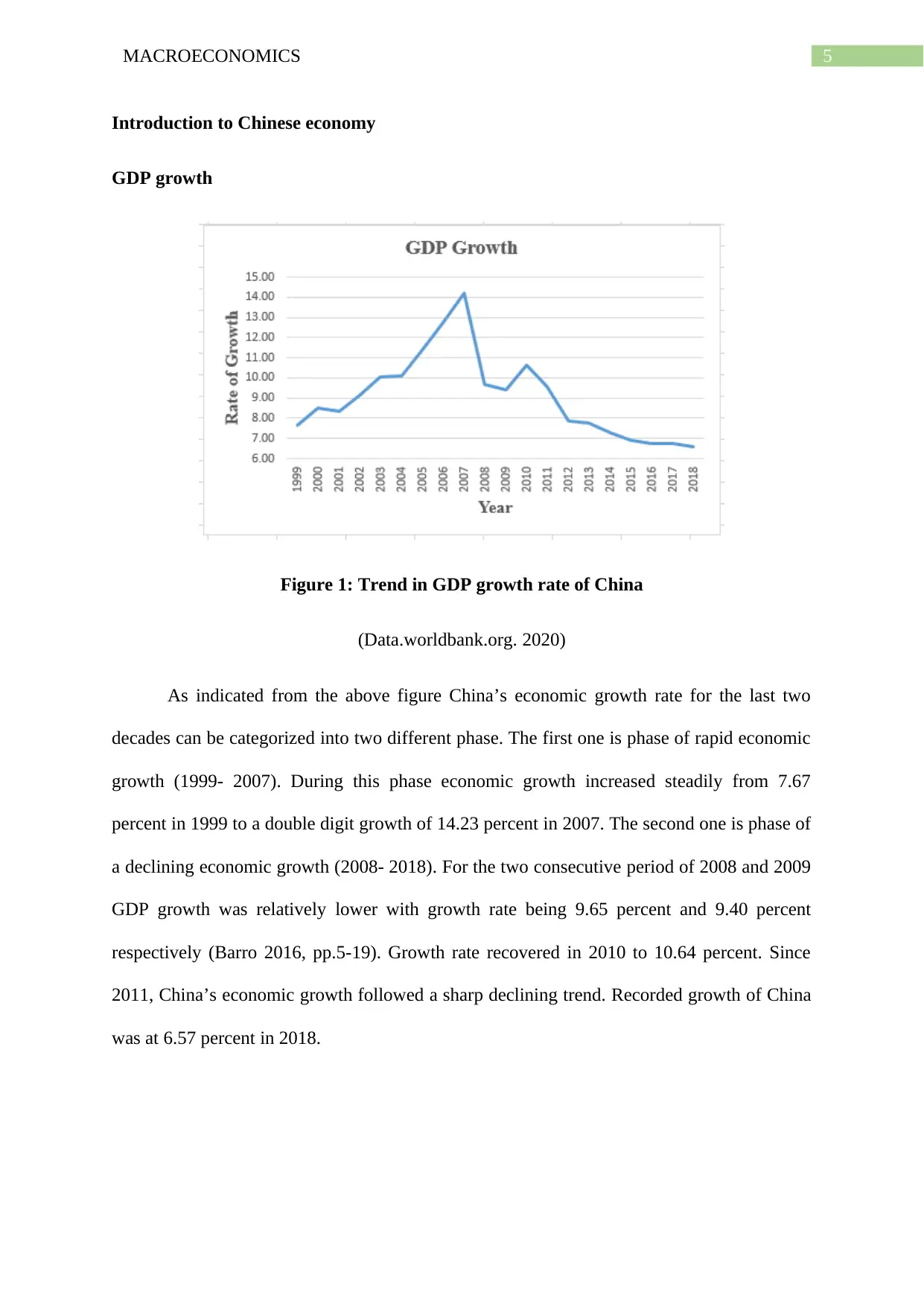
5MACROECONOMICS
Introduction to Chinese economy
GDP growth
Figure 1: Trend in GDP growth rate of China
(Data.worldbank.org. 2020)
As indicated from the above figure China’s economic growth rate for the last two
decades can be categorized into two different phase. The first one is phase of rapid economic
growth (1999- 2007). During this phase economic growth increased steadily from 7.67
percent in 1999 to a double digit growth of 14.23 percent in 2007. The second one is phase of
a declining economic growth (2008- 2018). For the two consecutive period of 2008 and 2009
GDP growth was relatively lower with growth rate being 9.65 percent and 9.40 percent
respectively (Barro 2016, pp.5-19). Growth rate recovered in 2010 to 10.64 percent. Since
2011, China’s economic growth followed a sharp declining trend. Recorded growth of China
was at 6.57 percent in 2018.
Introduction to Chinese economy
GDP growth
Figure 1: Trend in GDP growth rate of China
(Data.worldbank.org. 2020)
As indicated from the above figure China’s economic growth rate for the last two
decades can be categorized into two different phase. The first one is phase of rapid economic
growth (1999- 2007). During this phase economic growth increased steadily from 7.67
percent in 1999 to a double digit growth of 14.23 percent in 2007. The second one is phase of
a declining economic growth (2008- 2018). For the two consecutive period of 2008 and 2009
GDP growth was relatively lower with growth rate being 9.65 percent and 9.40 percent
respectively (Barro 2016, pp.5-19). Growth rate recovered in 2010 to 10.64 percent. Since
2011, China’s economic growth followed a sharp declining trend. Recorded growth of China
was at 6.57 percent in 2018.
⊘ This is a preview!⊘
Do you want full access?
Subscribe today to unlock all pages.

Trusted by 1+ million students worldwide

6MACROECONOMICS
Unemployment
Figure 2: Trend in unemployment rate of China
(Data.worldbank.org. 2020)
The unemployment rate of China was at a comparatively higher level. Despite a
steady increase in economic growth from 1999 to 2007, condition of unemployment did not
improve much during this period. Unemployment rate increased from 3.10 percent in 1997 to
4.00 percent in 2007. High rate of population growth and shift of the population to the urban
areas adversely affected employment condition in China. Considering the seriousness of
unemployment problem government has adapted policies to tackle the unemployment
problem. The active policy measures include creating opportunities of employment, reform in
the employment system and relocation of rural workers (Feng, Hu and Moffitt 2017, pp.304-
324). China’s unemployment rate began to decline since 2010 with unemployment declined
from 4.10 percent in 2010 to 3.80 percent in 2018.
Unemployment
Figure 2: Trend in unemployment rate of China
(Data.worldbank.org. 2020)
The unemployment rate of China was at a comparatively higher level. Despite a
steady increase in economic growth from 1999 to 2007, condition of unemployment did not
improve much during this period. Unemployment rate increased from 3.10 percent in 1997 to
4.00 percent in 2007. High rate of population growth and shift of the population to the urban
areas adversely affected employment condition in China. Considering the seriousness of
unemployment problem government has adapted policies to tackle the unemployment
problem. The active policy measures include creating opportunities of employment, reform in
the employment system and relocation of rural workers (Feng, Hu and Moffitt 2017, pp.304-
324). China’s unemployment rate began to decline since 2010 with unemployment declined
from 4.10 percent in 2010 to 3.80 percent in 2018.
Paraphrase This Document
Need a fresh take? Get an instant paraphrase of this document with our AI Paraphraser
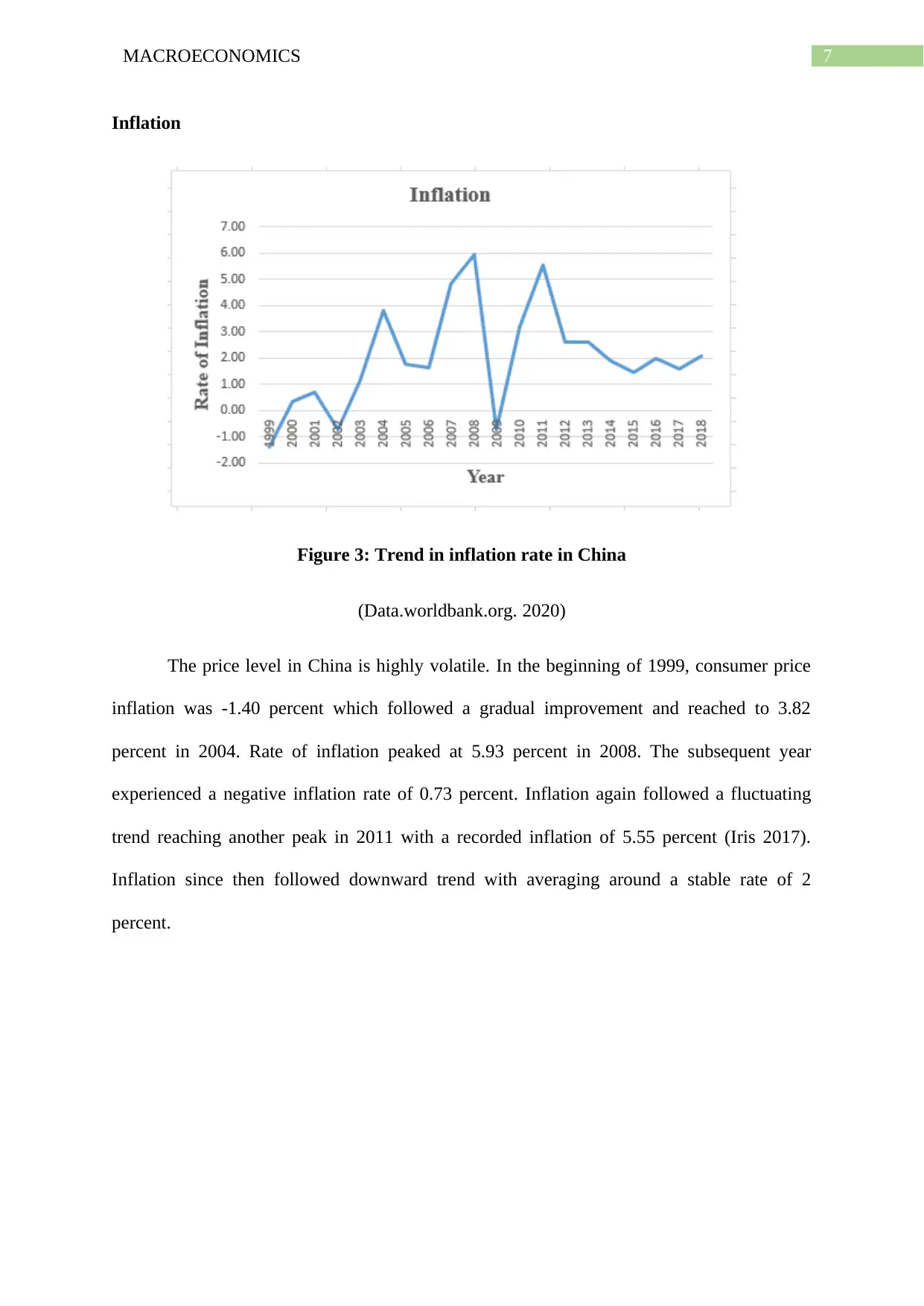
7MACROECONOMICS
Inflation
Figure 3: Trend in inflation rate in China
(Data.worldbank.org. 2020)
The price level in China is highly volatile. In the beginning of 1999, consumer price
inflation was -1.40 percent which followed a gradual improvement and reached to 3.82
percent in 2004. Rate of inflation peaked at 5.93 percent in 2008. The subsequent year
experienced a negative inflation rate of 0.73 percent. Inflation again followed a fluctuating
trend reaching another peak in 2011 with a recorded inflation of 5.55 percent (Iris 2017).
Inflation since then followed downward trend with averaging around a stable rate of 2
percent.
Inflation
Figure 3: Trend in inflation rate in China
(Data.worldbank.org. 2020)
The price level in China is highly volatile. In the beginning of 1999, consumer price
inflation was -1.40 percent which followed a gradual improvement and reached to 3.82
percent in 2004. Rate of inflation peaked at 5.93 percent in 2008. The subsequent year
experienced a negative inflation rate of 0.73 percent. Inflation again followed a fluctuating
trend reaching another peak in 2011 with a recorded inflation of 5.55 percent (Iris 2017).
Inflation since then followed downward trend with averaging around a stable rate of 2
percent.

8MACROECONOMICS
Current account balance
Figure 4: Trend in current account balance of China
(Data.worldbank.org. 2020)
The current account balance of Chins shows a steady improvement. The current
account surplus increased sharply from 21.12 billion dollars in 1991 to the highest level of
420.57 billion dollars in 2008. The main reason for growing surplus in current account of
China is rapid expansion of export to rich countries across the world (Chan 2019, pp.345-
359). Surplus in the current account though fell to 243.26 billion dollars it again increased to
304.16 billion dollars in 2015. The recently triggered trade war with USA has hampered
export earnings of China resulting in a decline in current account surplus to 49.09 billion
dollars.
Effect of appreciation of exchange rate on current account
Appreciation in the exchange rate refers to an increase in value of domestic currency
against the foreign currency. Exchange rate which indicates the relative value of currency is a
vital determinant of trade balance which directly affects current account balance. When a
Current account balance
Figure 4: Trend in current account balance of China
(Data.worldbank.org. 2020)
The current account balance of Chins shows a steady improvement. The current
account surplus increased sharply from 21.12 billion dollars in 1991 to the highest level of
420.57 billion dollars in 2008. The main reason for growing surplus in current account of
China is rapid expansion of export to rich countries across the world (Chan 2019, pp.345-
359). Surplus in the current account though fell to 243.26 billion dollars it again increased to
304.16 billion dollars in 2015. The recently triggered trade war with USA has hampered
export earnings of China resulting in a decline in current account surplus to 49.09 billion
dollars.
Effect of appreciation of exchange rate on current account
Appreciation in the exchange rate refers to an increase in value of domestic currency
against the foreign currency. Exchange rate which indicates the relative value of currency is a
vital determinant of trade balance which directly affects current account balance. When a
⊘ This is a preview!⊘
Do you want full access?
Subscribe today to unlock all pages.

Trusted by 1+ million students worldwide
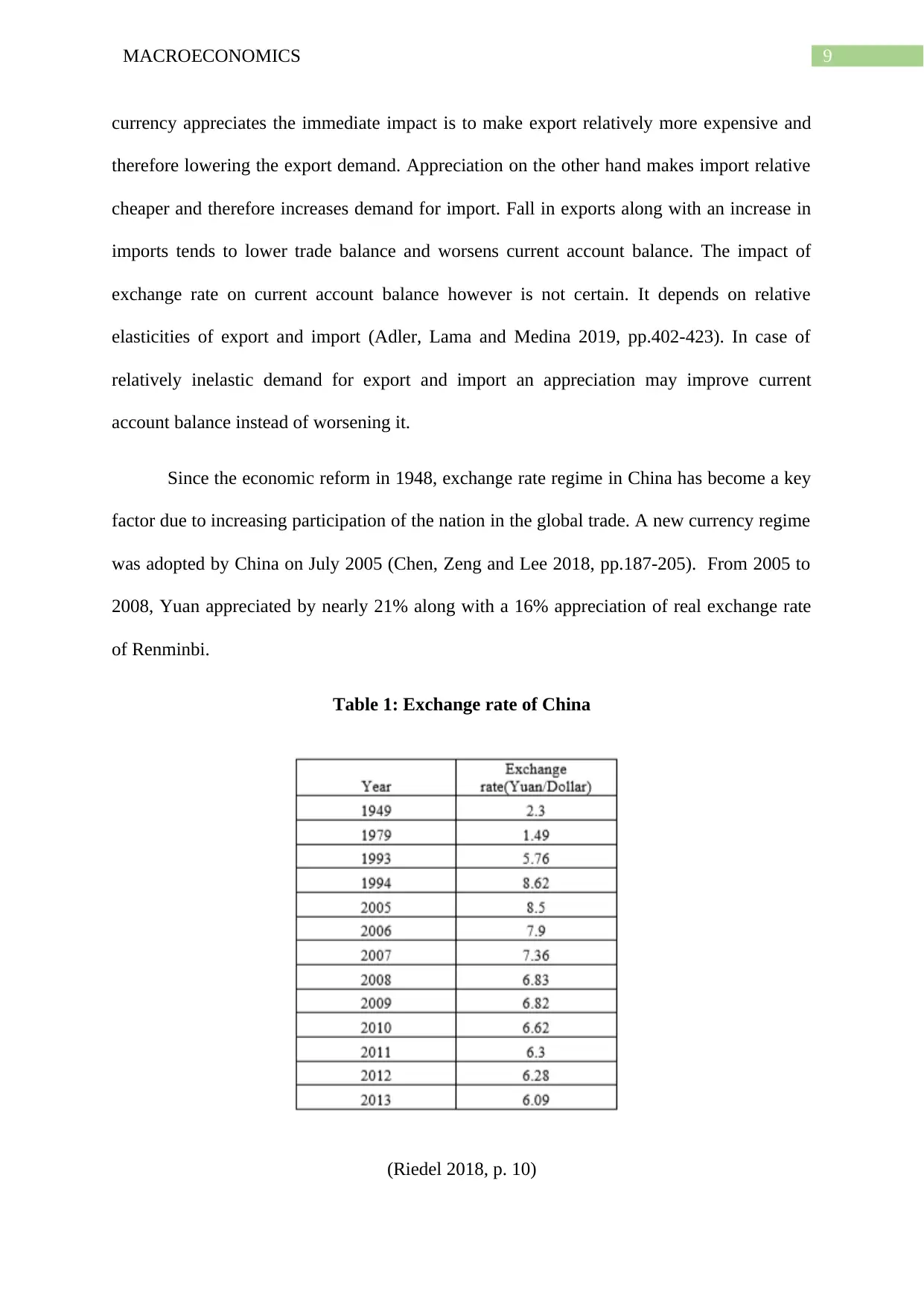
9MACROECONOMICS
currency appreciates the immediate impact is to make export relatively more expensive and
therefore lowering the export demand. Appreciation on the other hand makes import relative
cheaper and therefore increases demand for import. Fall in exports along with an increase in
imports tends to lower trade balance and worsens current account balance. The impact of
exchange rate on current account balance however is not certain. It depends on relative
elasticities of export and import (Adler, Lama and Medina 2019, pp.402-423). In case of
relatively inelastic demand for export and import an appreciation may improve current
account balance instead of worsening it.
Since the economic reform in 1948, exchange rate regime in China has become a key
factor due to increasing participation of the nation in the global trade. A new currency regime
was adopted by China on July 2005 (Chen, Zeng and Lee 2018, pp.187-205). From 2005 to
2008, Yuan appreciated by nearly 21% along with a 16% appreciation of real exchange rate
of Renminbi.
Table 1: Exchange rate of China
(Riedel 2018, p. 10)
currency appreciates the immediate impact is to make export relatively more expensive and
therefore lowering the export demand. Appreciation on the other hand makes import relative
cheaper and therefore increases demand for import. Fall in exports along with an increase in
imports tends to lower trade balance and worsens current account balance. The impact of
exchange rate on current account balance however is not certain. It depends on relative
elasticities of export and import (Adler, Lama and Medina 2019, pp.402-423). In case of
relatively inelastic demand for export and import an appreciation may improve current
account balance instead of worsening it.
Since the economic reform in 1948, exchange rate regime in China has become a key
factor due to increasing participation of the nation in the global trade. A new currency regime
was adopted by China on July 2005 (Chen, Zeng and Lee 2018, pp.187-205). From 2005 to
2008, Yuan appreciated by nearly 21% along with a 16% appreciation of real exchange rate
of Renminbi.
Table 1: Exchange rate of China
(Riedel 2018, p. 10)
Paraphrase This Document
Need a fresh take? Get an instant paraphrase of this document with our AI Paraphraser
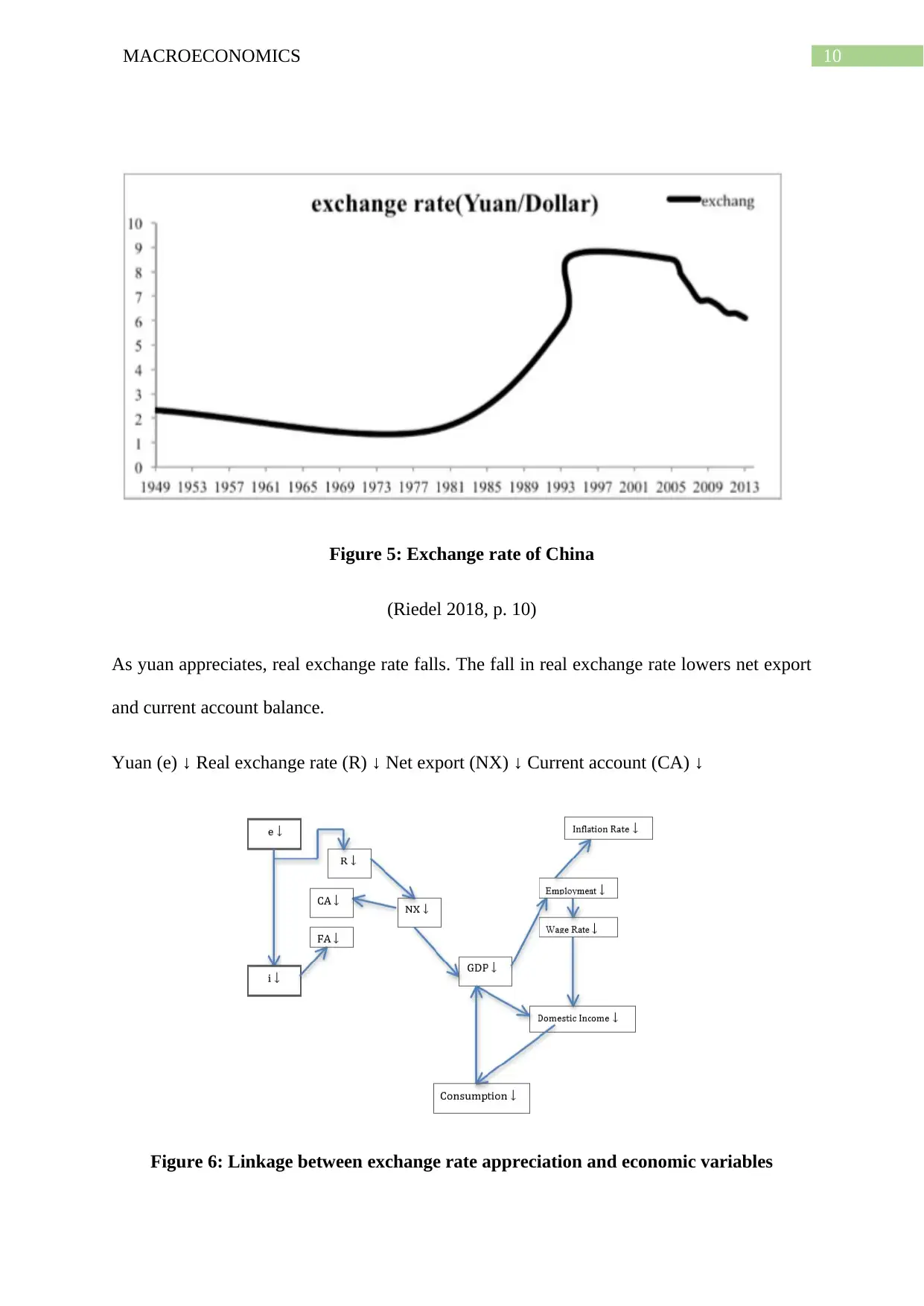
10MACROECONOMICS
Figure 5: Exchange rate of China
(Riedel 2018, p. 10)
As yuan appreciates, real exchange rate falls. The fall in real exchange rate lowers net export
and current account balance.
Yuan (e) ↓ Real exchange rate (R) ↓ Net export (NX) ↓ Current account (CA) ↓
Figure 6: Linkage between exchange rate appreciation and economic variables
Figure 5: Exchange rate of China
(Riedel 2018, p. 10)
As yuan appreciates, real exchange rate falls. The fall in real exchange rate lowers net export
and current account balance.
Yuan (e) ↓ Real exchange rate (R) ↓ Net export (NX) ↓ Current account (CA) ↓
Figure 6: Linkage between exchange rate appreciation and economic variables
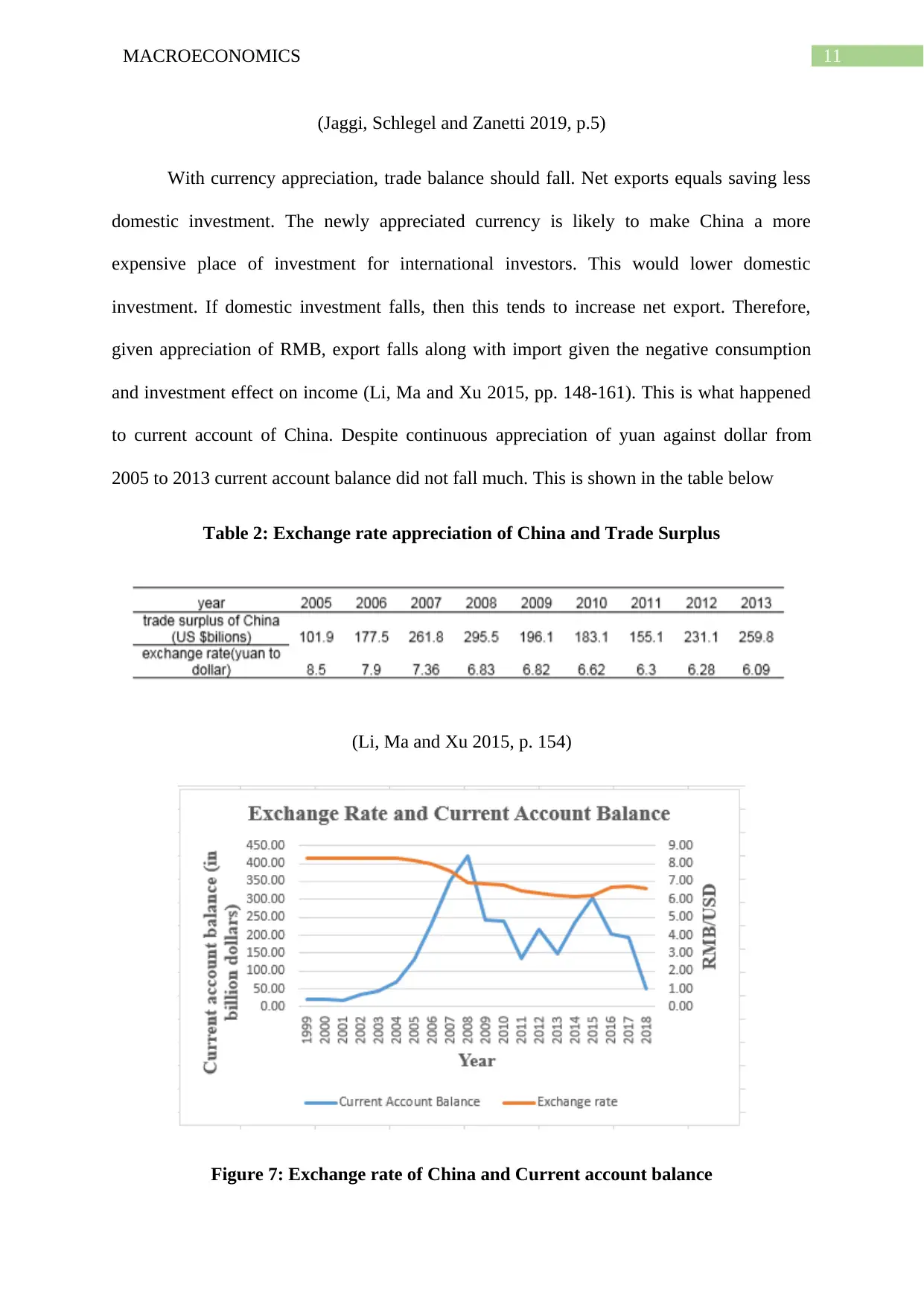
11MACROECONOMICS
(Jaggi, Schlegel and Zanetti 2019, p.5)
With currency appreciation, trade balance should fall. Net exports equals saving less
domestic investment. The newly appreciated currency is likely to make China a more
expensive place of investment for international investors. This would lower domestic
investment. If domestic investment falls, then this tends to increase net export. Therefore,
given appreciation of RMB, export falls along with import given the negative consumption
and investment effect on income (Li, Ma and Xu 2015, pp. 148-161). This is what happened
to current account of China. Despite continuous appreciation of yuan against dollar from
2005 to 2013 current account balance did not fall much. This is shown in the table below
Table 2: Exchange rate appreciation of China and Trade Surplus
(Li, Ma and Xu 2015, p. 154)
Figure 7: Exchange rate of China and Current account balance
(Jaggi, Schlegel and Zanetti 2019, p.5)
With currency appreciation, trade balance should fall. Net exports equals saving less
domestic investment. The newly appreciated currency is likely to make China a more
expensive place of investment for international investors. This would lower domestic
investment. If domestic investment falls, then this tends to increase net export. Therefore,
given appreciation of RMB, export falls along with import given the negative consumption
and investment effect on income (Li, Ma and Xu 2015, pp. 148-161). This is what happened
to current account of China. Despite continuous appreciation of yuan against dollar from
2005 to 2013 current account balance did not fall much. This is shown in the table below
Table 2: Exchange rate appreciation of China and Trade Surplus
(Li, Ma and Xu 2015, p. 154)
Figure 7: Exchange rate of China and Current account balance
⊘ This is a preview!⊘
Do you want full access?
Subscribe today to unlock all pages.

Trusted by 1+ million students worldwide
1 out of 16
Related Documents
Your All-in-One AI-Powered Toolkit for Academic Success.
+13062052269
info@desklib.com
Available 24*7 on WhatsApp / Email
![[object Object]](/_next/static/media/star-bottom.7253800d.svg)
Unlock your academic potential
Copyright © 2020–2025 A2Z Services. All Rights Reserved. Developed and managed by ZUCOL.





